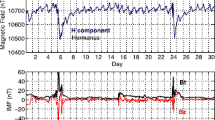Abstract
After a short review of the problems arising from wire-angle, and a consideration of some views expressed and results obtained by earlier writers, a description is given of two devices designed to measure the shape of terminally-weighted wires let down into the sea with water-bottles attached. Both devices can be used intermediately between water bottles and, whilst customarily operated by messengers, they can function via the solution of restraining tablets. One of them contains a compass which serves to reveal the directions of those curvatures in a loaded suspension wire which can be produced when deep currents cause a pronounced leading-away of a wire whose departure angle is kept negligible by manoeuvring the ship. Particular usefulness is seen for the devices when bottle lowerings have to be made well below the depth limit of unprotected reversing thermometers. This latter is usually about 5,500 metres but very exceptionally 7,000 metres.
Finally a description is given of a very simple device which records the slant of a rope buoyed from an anchor. The purpose in this case is to learn the heights above bottom at which an affixed current-meter has worked.
Zusammenfassung
Anschließend an einen kurzen Überblick über die Probleme, die mit dem „Drahtwinkel“ zusammenhängen, und an eine Betrachtung der Ansichten und Ergebnisse früherer Autoren werden zwei Vorrichtungen beschrieben, die es gestatten, die Gestalt eines Drahtes zu bestimmen, der mit Wasserschöpfern und einem am Ende befestigten Gewicht in die See hinabgelassen ist. Beide Vorrichtungen lassen sich zwischen den Wasserschöpfern anbringen. Sie werden gewöhnlich durch Fallgewichte ausgelöst; es können aber auch Sperrstücke verwendet werden, die sich im Wasser auflösen.
Das eine der Geräte enthält einen Kompaß. Er dient dazu, die Richtung von Ausbuchtungen zu ermitteln, die ein belasteter Aufhängedraht infolge von Tiefenströmen auch dann in ausgeprägtem Maße erfahren kann, wenn der Drahtwinkel am oberen Ende durch Schiffsmanöver vernachlässigbar klein gehalten wird.
Die Geräte versprechen besonderen Nutzen, wenn Wasserschöpfer in Bereiche merklich unterhalb der Grenztiefe für ungeschützte Umkippthermometer zu bringen sind, d. h. in Tiefen von mehr als 5500 m, in seltenen Ausnahmen von 7000 m.
Schließlich wird ein ganz einfaches Gerät beschrieben, welches die Schräge einer an einem Anker befestigten Bojentrosse aufzeichnet. Sein Zweck ist die Bestimmung der Tiefe über Grund, in der ein angehängter Strommesser gearbeitet hat.
Résumé
Après un bref exposé des problèmes posés par l'“inclinaison du cable”, et un examen des idées émises et des résultats obtenus par les auteurs antérieurs, l'auteur décrit deux appareils destinés à déterminer la forme de cables lestés à leur extrémité et filés à la mer avec des bouteilles de prise d'eau. Les deux dispositifs peuvent être intercalés entre les bouteilles et, bien qu'actionnés ordinairement par des messagers, il peuvent aussi fonctionner grâce à la dissolution de goupilles en matière fondante.
L'un d'eux renferme un compas destiné à manifester les directions des courbures prises par le fil chargé sous l'effet de courants profonds entraînant une déviation notable du cable, alors que son inclinaison au départ est maintenue négligeable par des manoeuvres du navire.
Ces appareils présentent un intérêt particulier lorsque l'immersion adoptée par les bouteilles dépasse sensiblement la profondeur limite d'emploi des thermomètres à renversement non protégés. Cette limite est en général à 5500 m de profondeur; elle s'étend dans des cas exceptionnels même jusqu'à 7000 m de profondeur.
L'étude se termine par la description d'un dispositif très simple destiné à enregistrer l'inclinaison d'un orin fixé à un ancrage, en vue d'obtenir dans ce cas la hauteur au-dessus du fond à laquelle a fonctionné un mesureur de courant amarré à l'orin.
Similar content being viewed by others
References
Cromwell, Townsend, R. B. Montgomery, and E. D. Stroup, 1954: Equatorial Under-current in Pacific Ocean revealed by new methods. Science119, 3097, 648–649.
Gougenheim, A., 1938: Les corrections des sondages au plomb poisson. Ann. Hydrogr. 3e Serie,15, 77–96. Also in: Hydrogr. Rev.14, 2, 155–172.
Hirano, T., 1952: An attempt to correct errors of the sounding caused by wire inclination. J. Oceanogr. Soc. Japan8, 2, 43–50.
Kullenberg, B., 1951: On the shape and the length of the cable during deep-sea trawling. Rep. Swed. Deep-Sea Exped. 1947–48,2, Zoology, Fasc. 1, 31–44. Gothenburg.
Mosby, H., 1952: Wire-angle in oceanography. Bergen Univ. Arbok. Naturvit. rek. 2.
Pollak, M. J., 1950: Notes on determining the depths of sampling in serial oceanographic observations. J. Mar. Res.9, 1, 17–20.
Watson, E. E., 1953: An experiment to determine the hydrodynamical forces on a cable inclined to the direction of flow. J. Mar. Res.12, 3, 245–248.
Additional information
With an Appendix supplied later by Mr. A. J. Lee on page 33.
Rights and permissions
About this article
Cite this article
Carruthers, J.N. On the instrumental measurement of line shape under water. Deutsche Hydrographische Zeitschrift 7, 22–35 (1954). https://doi.org/10.1007/BF02019499
Published:
Issue Date:
DOI: https://doi.org/10.1007/BF02019499




